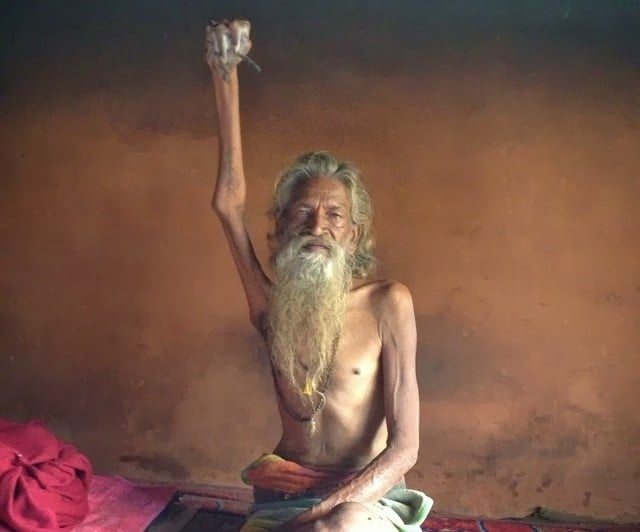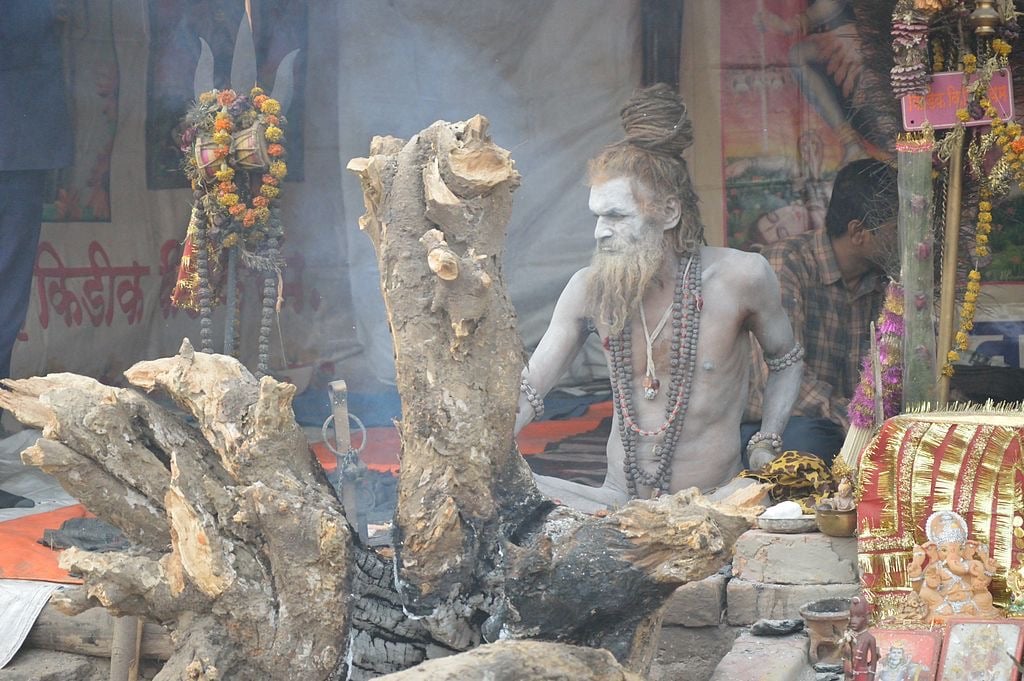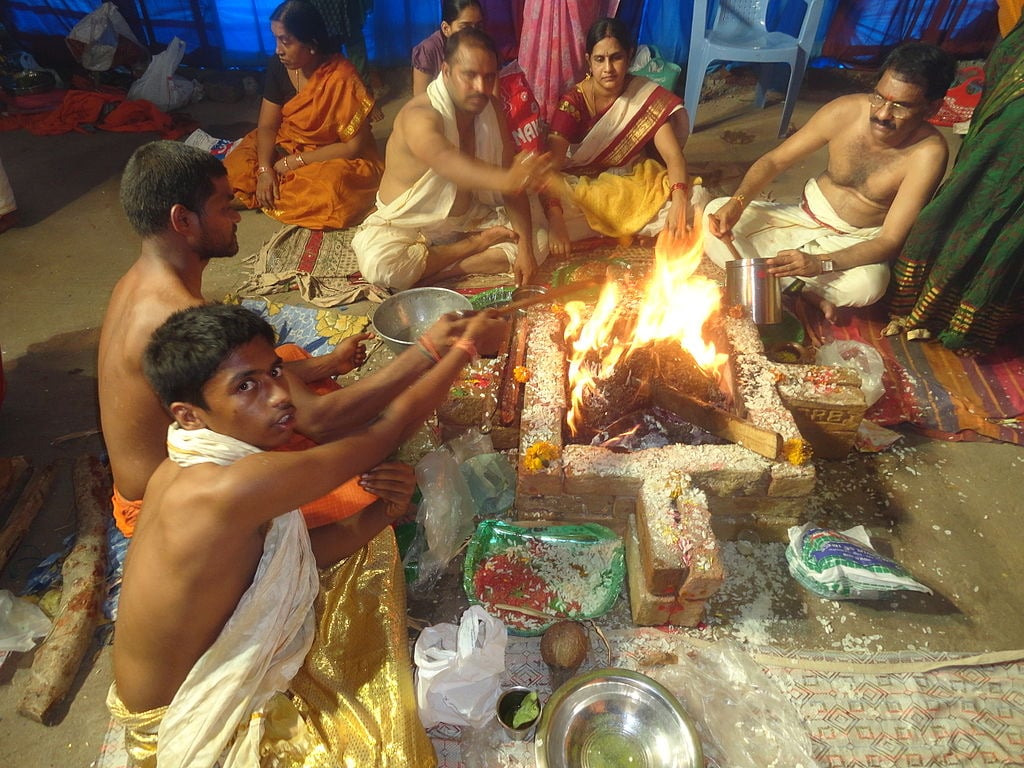
An Indian ascetic (sadhu) named Amar Bharati has been advocating for world peace for almost fifty years while holding up his right hand in the air without ever lowering it.
A sadhu is a religious ascetic or holy person in Hinduism (in some cases Buddhism and Jainism) who has rejected all worldly desires.
Bharati was a married man with three children who worked as a clerk in New Delhi until 1970, when he quit his job and left his family and friends to devote his life to Shiva, one of the principal deities of Hinduism, also called as “the primordial yogi”.
He raised his arm beginning in 1973 as a symbol of his devotion and “to militate against wars and support world peace.” By doing this, he endured excruciating pain for two years of his life, but eventually his arm lost all feeling and the muscles in his arm atrophied.
Indian sadhus often engage in the most austere forms of penance, requiring extreme self-discipline in order to achieve liberation and enlightenment, or Moksha, as this state is known in India.
A Hindu sadhu (holy person), Amar Bharati, lifted his right hand in 1973 and has held it up ever since.
He sees this as showing his dedication to Lord Shiva and his goal of promoting peace worldwide. Bharati is a well-known holy man who often joins in large religious events… pic.twitter.com/XQYkrc370j
— Fascinating (@fasc1nate) June 28, 2023
The sadhu previously stated in an interview with the History of Yesterday news site, “I do not ask for much. Why are we fighting our sons among ourselves? Why is there so much hatred and enmity between us? I just want all Indians and the whole world to live in peace with each other.”
Bharati can no longer bend his arm, as it is now merely a bony structure, and his nails have turned into spiraling claws. One can only imagine how much pain he must have endured! It is such extreme forms of self-punishment and the motivation behind these acts that have made Hindu asceticism a topic of great interest for non-Indians, Alexander the Great included.
World Peace and Indian Scriptures

World peace is something that Hindu spirituality and holy books have focused on for ages. This is why it is said that Indians have historically had a very pacifist dispensation. Ancient Indians assimilated waves of migrants who came to their land peacefully.
Assimilation has been phenomenally successful, and peace is mentioned throughout Hindu scriptures. The Vedas, a large body of religious texts originating in ancient India, contain the following verses:
“Let me see all living beings with a friendly vision. Let us see each other in the society with friendly eyes.”
“Oh, all protector God, let the leaders of our society be powerful and founders of peace…”
“unity of heart, and unity of mind, freedom from hatred.”
Upanishads, the late Vedic Sanskrit texts that supplied the basis of later Hindu philosophy examines the concept of “Vasudaiva Kutumbakam,” meaning “The World Is One Family,” and relates to universal acceptance of the world.
The Vedic ideology confers “Aham Brahmasmi,”one of the four principle “Great Sayings” from the Upanishads. It means “I am Brahman”(I am God). Brahma is a name for the Hindu god which can also be translated as “divine” or “sacred.” This concept is relevant to yoga philosophy and describes the unification of individual self or soul with the ‘Brahman’ or the absolute.
World peace and Indian ritual

The world’s oldest Vedic ritual, titled Athirathram—meaning “building up of a fireplace and performing yagna over night”—is in fact a call for world peace and protection of environment. Athirathram Yagam is only one of the various Vedic rituals performed by Kerala Namboodiries, a community of Brahmins in southwestern India.
This is a more practical application of Vedas. The message of this Yagam is peace and prosperity for all of humanity with the complete protection of the environment. The main aim of Athirathram Yagam is to spread positive energy waves by purifying the atmosphere to maintain the pollution free environment.
The gymnosophists of India
In Indian philosophy, it is said that there are two types of Vedic activity. The first of these is activity which brings about engagement through participation. The second is that which brings about disengagement and supreme good. It should be mentioned that Vedism is one of the oldest and major Indian religions which shaped Hinduism.
Engagement is said to be driven by desire in this world and the world beyond, whereas disengagement is said to be free of desire and motivated by knowledge. The man who is thoroughly dedicated to the activity of engagement becomes equal to the gods, but the man who is dedicated to disengagement passes even beyond the five elements.
Gymnosophists, referring to ‘naked philosophers’ or ‘naked wise men,’ was what the Greeks—especially Plutarch in his first century CE writing—called a group of individuals who practiced Indian asceticism and regarded food, clothing, and shelter as almost unnecessary. Gymnosophists even perceived of these things as impediments to purity of thought.
The English term, asceticism, derives from the Greek ‘askesis,’ originally meaning “to train” or “to exercise.” Nudity was and is in some cases practiced by Hindu, Jain, and Fatalist ascetics in India as a way to communicate that they have forfeited all worldly goods, including clothing.
The Vedas in some places say that the deities gained their status or even created the entire universe through the power of their inner, ascetic heat (tapas), acquired through the rigorous practice of physical and spiritual self-discipline and body mortification. The term tapas is derived from a Sanskrit root meaning to heat up or burn and refers to any one of a variety of ascetic methods for achieving religious power.
Some ascetics subsist solely on fruits, wild plants, and roots, or they nurture themselves only with grain from the fields. Among the most famous are ascetics who practice the “five fires” ritual. This ritual involves building four fires around oneself, with the sun as the fifth. Furthermore, “spike-lying” ascetics sleep on beds of nails.
Pray For World Peace
Penance is nothing new to Indians, and by now, it is probably quite clear that the ideology of “Vasudhaiv Kutumbakam,” meaning “The World Is One Family,” as formerly mentioned, is of vital important in the culture in general. Hence, world peace is also of the utmost value for Indians, and, more specifically, for Hindus, Buddhists, and Jains. Amar Bharati is a manifestation of that Ancient Indian ideology of live and let live and the ideology of world peace.
See all the latest news from Greece and the world at Greekreporter.com. Contact our newsroom to report an update or send your story, photos and videos. Follow GR on Google News and subscribe here to our daily email!



